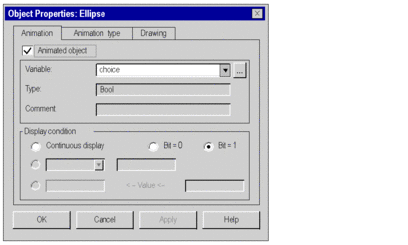At a Glance
All the graphic objects (simple or compound) that you create in a screen can be animated. This tab allows users to set the animation attributes of a graphic object.
to decide to animate an object,
to choose the animation variable,
to choose the display conditions.
Animation attributes setting screen
The following screen is used to set the animation attributes of a graphic object.

Description
The table below describes the settings that you may define.
Field |
Description |
|---|---|
Animated object |
The object is animated if this box is checked. |
button |
Calls the variable selection tool to select the variable to associate with the object. |
Variable |
The animation variable linked to the object. Possibilities:
|
Type |
Type of animation variable linked to the object. The type must be EDT (Bool, Ebool, Int, Dint, Uint, Udint, Real, Time...). It is not possible to use structures or tables. However, it is possible to use items from tables or structures if they are of type EDT. |
Comment |
Comment of the animation variable linked to the object. |
Display condition |
The object’s display condition:
|



